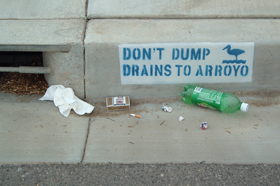The sewer system collects water from inside homes and businesses and carries it to a treatment plant where it is cleaned before being released into the ocean.The storm drains system collects water and litter from outside our homes and businesses and carries it, untreated directly to the ocean.
Stormwater is water from rain or melting snow that does not soak into the ground. It flows from rooftops, over paved areas and bare soil, and through sloped lawns. As it flows, this stormwater runoff collects litter, cigarette butts and anything in its path including the following pollutants:
| POLLUTANTS | SOURCES |
| Silt, sand, clay | Construction sites; bare spots in lawns and gardens; wastewater from sediment and other debris; washing cars and trucks on driveways or parking lots; dirt roads and driveways; unprotected stream banks and drainage-ways |
| Nutrients | Fertilizers; pet waste; grass clippings and leaves left on streets and sidewalks; leaves burned in ditches; atmospheric deposition |
| Disease organisms | Pet and wildlife waste; garbage |
| Hydrocarbons | Car and truck exhaust; leaks and spills of oil and gas; used oil dumping; burning leaves and garbage |
| Pesticides | Pesticides over-applied or applied before a rainstorm; spills and leaks |
| Metals | Cars and trucks (brake and tire wear, exhaust); galvanized metal gutters and downspouts; industrial activities |
Polluted stormwater degrades streams, rivers, ponds, wetlands, estuaries, sounds, and bays. Soil clouds water and deteriorates habitat for fish and plants. Nutrients such as nitrogen and phosphorus promote the growth of algae, which crowd out other aquatic life. Toxic chemicals, such as antifreeze and oil from leaking cars, carelessly applied pesticides, and zinc from galvanized metal gutters and downspouts, also threaten the health of fish and other aquatic life. Bacteria and parasites from pet waste and leaking septic tanks can make lakes and the ocean unsafe for wading and swimming after storms.
- Oil, anti-freeze, paint, cleaning fluids
- Wash water from a commercial car wash
- Industrial discharges
- Wash waters from commercial/industrial activities
- Contaminated foundation drains
- Sanitary sewer discharges
- Septic tank discharges
- Washing machine discharges
- Chlorinated backwash and draining associated with swimming pools
- Surface water
- Diverted stream flows
- Springs
- Flows from riparian habitats and wetlands
- Ground water
- Uncontaminated rising ground water
- Uncontaminated ground water
- Foundation drains
- Water from crawl space pumps
- Footing drains
- Potable water
- Irrigation water
- Landscape irrigation
- Lawn watering
- Dechlorinated backwash and draining associated with swimming pools per each city’s guidelines and restrictions
- Firefighting emergency activities
- Everybody can reduce pollution in stormwater by implementing a few good “housekeeping” practices.
- Maintain your automobile.
- Regular car maintenance can reduce oil drippings and other pollutants on the road.
- Use biodegradable products for landscaping, car washing, etc.
- Keep storm drains and street gutters clear of debris.
- Bag or mulch lawn clippings so they won’t wash into nearby storm drains.
- Clean up after your pets.
- Store and dispose of household chemicals properly. Always use them in the way they were intended. Seal the product to revent leakage. Take unwanted hazardous wastes to a proper disposal facility.
- Don’t treat roofs or driveways with toxic chemicals used for cleaning or moss retardation.
- Plant native vegetation
- Reduce your use of fertilizers, herbicides and pesticides in your yard and garden. If you do apply fertilizer and chemicals to your lawn, follow the application instructions found on the label.
Best Management Practices (BMPs) are good housekeeping solutions that include the proper handling, storage, and disposal of toxic materials to prevent stormwater pollution. Click here for a complete list of BMP fact sheets.
Go to www.wasteless.org for detailed information on both residential and commercial recycling and hazardous waste collection programs.



